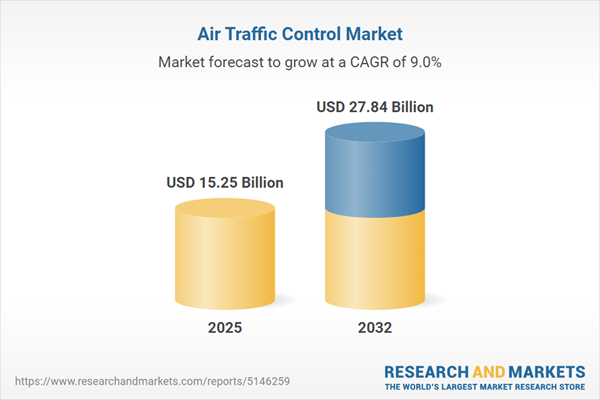Speak directly to the analyst to clarify any post sales queries you may have.
The air traffic control market is undergoing rapid transformation, driven by rising complexity in airspace, evolving regulatory demands, and the accelerated adoption of advanced digital and automation technologies. Senior leaders face increasing pressure to align operational resilience and security with scalable, future-ready investments.
Market Snapshot: Air Traffic Control Market Growth and Outlook
The air traffic control market grew from USD 14.00 billion in 2024 to USD 15.25 billion in 2025. Projected to maintain robust momentum with a CAGR of 8.96%, the market is expected to reach USD 27.84 billion by 2032. This significant growth reflects an industry pivoting toward greater safety, efficiency, and automation across global airspace management functions.
Scope & Segmentation
This report delivers in-depth analysis and forecasts on emerging opportunities and challenges throughout the air traffic control value chain. The research encompasses the following elements:
- Components: Communication equipment (antenna, radios), displays, radar systems (air surveillance radar, precision approach radar, surface movement radars), services (installation & integration, maintenance & support, training & consulting), and software solutions (ATC simulation software, predictive analytics software, surveillance software).
- Facility Types: Air traffic control towers, area control centers, combined center radar approach control, and terminal radar approach control.
- Airport Size: Large, medium, and small hubs, each with distinct procurement cycles and technology priorities.
- Application Areas: Automation, communication, navigation, and surveillance platforms, reflecting evolving operational requirements.
- End-User Segments: Commercial aviation and military aviation, with focus areas ranging from passenger experience to secure command and control.
- Geographic Coverage: Americas (United States, Canada, Mexico, Brazil, Argentina, Chile, Colombia, Peru), Europe (United Kingdom, Germany, France, Russia, Italy, Spain, Netherlands, Sweden, Poland, Switzerland), Middle East (United Arab Emirates, Saudi Arabia, Qatar, Turkey, Israel), Africa (South Africa, Nigeria, Egypt, Kenya), and Asia-Pacific (China, India, Japan, Australia, South Korea, Indonesia, Thailand, Malaysia, Singapore, Taiwan).
- Company Analysis: ACAMS AS, Adacel Technologies Limited, ALTYS Technologies, ARTISYS, s.r.o., Avinor AS, BAE Systems PLC, Collins Aerospace, DFS Deutsche Flugsicherung GmbH, Frequentis AG, Honeywell International Inc., Huber+Suhner AG, Intelcan Technosystems Inc., L3harris Technologies, Inc., Leonardo Group by Indra Sistemas, S.A., Midwest Air Traffic Control Service, Inc., NATS Limited, Nav Canada, Northrop Grumman Corporation, Raytheon Technologies Corporation, Saab AB, Saipher ATC, SkySoft-ATM, Thales Group.
Key Takeaways for Senior Decision-Makers
- Regulatory mandates and evolving safety protocols are accelerating adoption of unified digital systems that improve operational efficiency and support seamless information exchange.
- Growing integration of artificial intelligence and machine learning is enabling advanced flight trajectory optimization and predictive system maintenance, directly impacting controller workload and hardware reliability.
- Regional factors, including expansion in Asia-Pacific and the modernization of infrastructure across the Americas, necessitate tailored go-to-market approaches aligned with diverse regulatory and investment environments.
- Collaboration between technology vendors, system integrators, and regional partners is vital to address localized requirements, manage interoperability, and strengthen supply chain resilience.
- Emphasis on modular architectures and open systems fosters agility and positions organizations to capitalize on third-party innovation while mitigating risks of vendor lock-in.
Tariff Impact: Navigating Economic Headwinds
The introduction of new United States tariff measures in 2025 creates additional economic complexity for equipment procurement and system integration. Increased duties on hardware components prompt a reassessment of cost structures, with downstream impacts on service pricing, domestic manufacturing, and partnership strategies. Industry participants are accelerating efforts to localize supply chains and develop modular, scalable solutions adaptable to changing trade environments. Financial planning and scenario modeling remain essential for sustaining cost efficiency and service quality amid evolving tariff landscapes.
Methodology & Data Sources
This report synthesizes insights from extensive primary interviews, quantitative surveys, and secondary research. Executive-level dialogues, technical standards reviews, and scenario-based analysis ensure the data’s relevance, continuity, and analytical rigor. The methodology balances qualitative depth and quantitative validation, supporting executive decision-making with actionable intelligence.
Why This Air Traffic Control Market Report Matters
- Enables executives to identify growth opportunities and proactively manage risk in a rapidly evolving regulatory and technological context.
- Supports informed investment and policy decisions through objective benchmarking of regional trends, company strategies, and supply chain resilience.
- Delivers actionable recommendations for enhancing operational efficiency, system interoperability, and talent readiness in a dynamic ecosystem.
Conclusion
As the air traffic control market enters a new era shaped by digital innovation and operational complexity, strategic adaptability and data-driven planning are crucial for success. This report provides senior decision-makers with the insights needed to navigate change, optimize investments, and build long-term value in airspace management.
Additional Product Information:
- Purchase of this report includes 1 year online access with quarterly updates.
- This report can be updated on request. Please contact our Customer Experience team using the Ask a Question widget on our website.
Table of Contents
3. Executive Summary
4. Market Overview
7. Cumulative Impact of Artificial Intelligence 2025
Companies Mentioned
The companies profiled in this Air Traffic Control market report include:- ACAMS AS
- Adacel Technologies Limited
- ALTYS Technologies
- ARTISYS, s.r.o.
- Avinor AS
- BAE Systems PLC
- Collins Aerospace
- DFS Deutsche Flugsicherung GmbH
- Frequentis AG
- Honeywell International Inc.
- Huber+Suhner AG
- Intelcan Technosystems Inc.
- L3harris Technologies, Inc.
- Leonardo Group by Indra Sistemas, S.A.
- Midwest Air Traffic Control Service, Inc.
- NATS Limited
- Nav Canada
- Northrop Grumman Corporation,
- Raytheon Technologies Corporation
- Saab AB
- Saipher ATC
- SkySoft-ATM
- Thales Group
Table Information
| Report Attribute | Details |
|---|---|
| No. of Pages | 195 |
| Published | November 2025 |
| Forecast Period | 2025 - 2032 |
| Estimated Market Value ( USD | $ 15.25 Billion |
| Forecasted Market Value ( USD | $ 27.84 Billion |
| Compound Annual Growth Rate | 8.9% |
| Regions Covered | Global |
| No. of Companies Mentioned | 24 |









